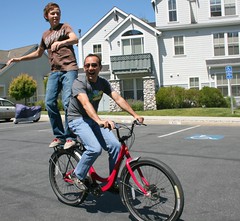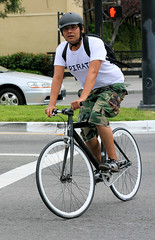Notwithstanding my earlier post today on road rage and harassment, almost all of my bike rides are without incident. And so are yours.
Somebody posted a request for a bike route across San Jose on a local discussion list last night. He quit riding 20 years ago after he was hit by a car. He’d like to give biking to work a shot again now, but it’s just so dangerous, don’t you know.
How do you address something like that? Irrationality is part of the human experience. I know there’s an uncontrollable animal aspect to fear and I have first hand experience with the tremendous adrenalin surge that happens after a hard thump from a motor vehicle.
I have to wonder, though: How many people quit driving after they’ve been in a car wreck? About one fourth of the U.S. population have been or will be involved in a car collision, but anybody with a driving phobia is seen as strange and in need of therapy, while a fear of cycling is seen as a healthy and appropriate response to our hazardous roads, even in various online bicycling forums.
The cycling echo chamber too often reinforces the dangers, risks and hassles of cycling over the fun, freedom and exhilaration. I’m guilty of this myself, but I began Cyclelicious six years ago partly to counteract the fear-based advocacy that seems so prevalent. Yes, bicycling can and should be safer in the United States, but it’s really not that much more dangerous than riding in a car.
Vik the lazy Randonneur rants at length about “The Safety Myth” and the extent some cyclists go to achieve what he calls “Most-Safer” cycling. He begins provocatively with “The number one threat to cycling in North America is fear – nothing else comes close to doing the same damage” and moves on from there to evidence based risk mitigation.
Vik’s solution is to fight fear with logic. I’m a big believer in education to increase a cyclist’s confidence in riding with traffic, but I don’t know that to be a complete solution. Mikael’s Copenhagen Cycle Chic has probably done more to normalize cycling and make it seem safer and more mainstream than 50 years of cycling education have done. Group rides — whether they’re formal road confidence education rides, roadie club rides, town cruiser tours or even “bike party” style rides — can also work effectively to increase a bike riders confidence, though, admittedly, this is completely anecdotal.
Kent’s response is sort of along the same lines as mine here. Kent acknowledges that cycling is safer than many people realize, but he also understands personal experience drives an irrationally emotional response that can overpower volumes of empirical data. We’re not robots with risk / reward analysis programmed into our skulls, but we’re complex, emotional beings who, at times, act irrationally.
Perception is reality. For some people, Joe Friday’s “Just the facts, Ma’am” approach to bike psychic comfort works fine. Most people, however, require encouragement beyond simple statistics and intellectual browbeating.


Fear is exactly what keeps my wife off the roads on her bike, even though she used to commute by bike daily from the Upper Haight to SOMA by bike from the mid-90s to late 2001. Our first date was a bike ride to Sausalito, but we now basically never ride together anymore. This fear also affects the amount of permission I have to take my kids out for a ride in San Francisco (either on their own bikes / trail-a-bike, or in the kid trailer). As a result, my kids are often stuck riding supervised loops in a dead-end street near our house, even though we live 4 blocks from Golden Gate Park. No amount of visual evidence (“See, look, a very responsible-looking mom with a kid on the front AND back of her bike!”) that it’s not actually a death wish has been effective so far.
I am almost desperate to find an effective way to counter / ease this fear so that we can enjoy riding our bikes as a family, rather than it just being “something Daddy does”.
That’s the rub, isn’t it?
I Google “Fear of Driving” and see immediately see dozens of services offering to help people overcome their driving phobia. I Google “Fear of Cycling” and I see several essays about this fear similar to mine (including Dave Horton’s excellent series at Copenhagenize, but with no individual solutions.
I had a bad day last week with an abnormally high number of people honking or shouting at me. I was riding the same way I normally do, so I was really confused and intimidated.
I’m still kinda trying to get over that. I know I need to HTFU mentally, but some days it’s hard. I’m still pretty glum about it. 🙁
I know, I’m a weenie.
No, not a weenie; human. And I know the feeling.
Take advantage of Sunday Streets and the GG Park car-free Sundays as much as possible, and extend the ride from Ocean Beach through to the Panhandle. Keep that up until all in your family are comfortable with that ride, then slowly extend to fun spots at either end.
Great post.
There are a couple points that people should know, but most do not:
1. You, as an American, are more likely to die in a car than on a bicycle.
2. If more people cycled, cycling would become safer (and so would driving with the reduced congestion).
Great post.
There are a couple points that people should know, but most do not:
1. You, as an American, are more likely to die in a car than on a bicycle.
2. If more people cycled, cycling would become safer (and so would driving with the reduced congestion).
I’ve been in any number of bicycle-only crashes, but I’ve only hit once by a car. That collision was the only time I felt in real fear for my life, with time slowed down to a few sequences of sound and fury, the car’s tires squealing behind me, and drivers in front squeezing me in, and me waiting-waiting-waiting for impact. That one kept me up for a few nights.
I don’t think it’s fair to trivialize cycling fear by saying “people die in cars, too.” Yes, they do, but that’s isn’t quite the point. People die in cars largely because they’re going too fast, perhaps traveling down a freeway at high speeds. They’re not usually negotiating urban traffic at urban speeds, which is where we expect new cyclists to ride their bikes. Cars in urban environments largely get into fender benders, and if you’ve driven long enough, you’ve been in a few. Cars and bicycles get into more than a fender bender, obviously.
I’m going to keep riding, mostly because I love it. But I don’t think I’m ever going to convince anyone that cycling down, say, Santa Monica or Sunset Boulevard is as safe as driving them. It’s just not.
This is a really great post, Richard….one of your best. Super good stuff and thanks for providing the links to those other stories as well. I love the top photo.
Darryl
Hear hear!
I made a similar point recently when a reader asked me, ‘Should I try commuting again?’
I didn’t want to dismiss the fears of someone who’s been in a bone-breaking accident, but a similar thought occurred to me:
“[Y]ou rarely (or never) hear of a motorist who needs to be coaxed back into using cars again after an accident. You do, however, hear of motorists who become much safer drivers after an accident. Why should cycling be any different, except that we tend to consider car use as obligatory, and bike use as optional?”